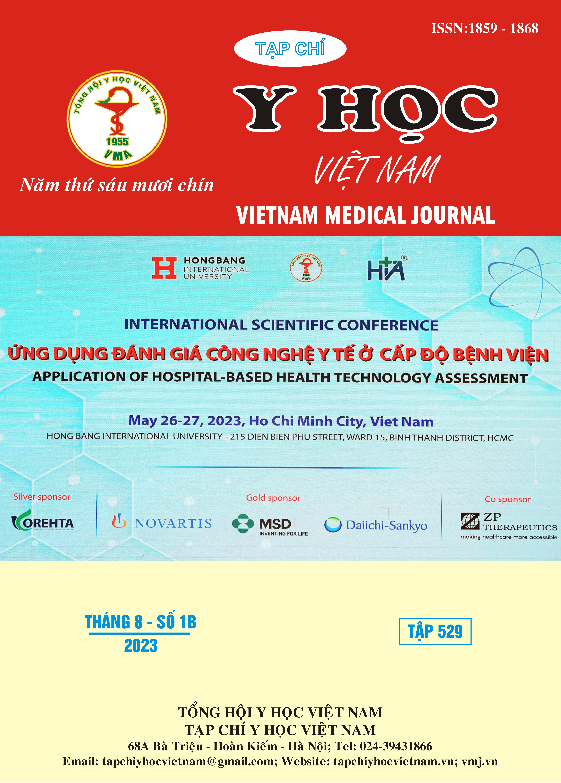TỶ LỆ NHIỄM KÝ SINH TRÙNG VÀ MỐI TƯƠNG QUAN VỚI CÁC ĐẶC ĐIỂM Ở NGƯỜI NUÔI CHÓ TẠI XÃ DÂN THÀNH, TỈNH TRÀ VINH
Nội dung chính của bài viết
Tóm tắt
Đặt vấn đề: Việt Nam là nước có nhiều điện kiện tự nhiên thuận lợi cho sự phát triển của các loài ký sinh trùng gây bệnh cho người. Hội chứng ấu trùng di chuyển gây ra bởi ấu trùng giun lươn, ấu trùng giun đũa chó mèo có biểu hiện lâm sàng đa dạng, kỹ thuật chẩn đoán chủ yếu dựa vào huyết thanh học. Mục tiêu: Khảo sát tỷ lệ nhiễm ký sinh trùng bằng kỹ thuật ELISA và xem xét mối tương quan giữa thực trạng nhiễm ký sinh trùng với các đặc điểm ở người nuôi chó tại xã Dân Thành, tỉnh Trà Vinh. Đối tượng và phương pháp: Nghiên cứu cắt ngang mô tả từ tháng 1 đến tháng 2 năm 2023, mẫu huyết thanh của người tham gia nghiên cứu được xét nghiệm bằng kỹ thuật ELISA, ghi nhận các đặc điểm về xã hội, dấu hiệu lâm sàng và các đặc điểm về thói quen. Kết quả: Tỷ lệ nhiễm ký sinh trùng được xác định bằng kỹ thuật ELISA là 34,09%. Trong đó tỷ lệ nhiễm Toxocara spp. là 19,32% và tỷ lệ nhiễm Strongyloides stercoralis là 15,91%. Có mối liên quan giữa tỷ lệ nhiễm ký sinh trùng với các thói quen của người dân như rửa tay sau khi tiếp xúc chó mèo, tiếp xúc với chó mèo (ôm, vuốt ve, hôn,…), rửa tay sau khi tiếp xúc trực tiếp với đất cát (p < 0,05). Kết luận: Tỷ lệ nhiễm ký sinh trùng tại địa phương tương đối cao 34,09%. Cần tăng cường các hoạt động tuyên truyền kiến thức phòng chống bệnh do ký sinh trùng gây ra.
Chi tiết bài viết
Từ khóa
Toxocara spp., Strongyloides stercoralis, ELISA, IgG, thói quen.
Tài liệu tham khảo
2. Nguyễn Thị Nga, Lê Trần Anh, Nguyễn Khắc Lực. Đặc điểm kiến thức và thực hành nuôi chó, mèo liên quan đến nhiễm Toxocara spp. ở bệnh nhân đến khám và điều trị tại viện 103 (2012 - 2013). Tạp chí Y Học thực hành - Bộ Y Tế. 2013;878:113 - 115.
3. Trần Vinh HIển, Trần Thị Kim Dung. Ký sinh trùng liên quan giữa thú và người. 2008:54 - 57.
4. Nguyen T, Cheong FW, Liew JW, Lau YL. Seroprevalence of fascioliasis, toxocariasis, strongyloidiasis and cysticercosis in blood samples diagnosed in Medic Medical Center Laboratory, Ho Chi Minh City, Vietnam in 2012. Parasit Vectors. Sep 5 2016;9(1):486. doi:10.1186/s13071-016-1780-2
5. Ngô Thị Minh Châu, Tôn Nữ Phương Anh, Lê Chí Cao, Võ Minh Tiếp, Nguyễn Phước Vinh, Trần Thị Giang. Tỷ lệ huyết thanh dương tính và đánh giá các tiêu chuẩn chẩn đoán bệnh ấu trùng giun đũa chó mèo (Toxocara spp.) ở bệnh nhân tại bệnh viện trường Đại học Y Dược Huế. Tạp chí Y Học TP Hồ Chí Minh. 2021;Tập 25:76 - 83.
6. Nguyễn Tấn Vinh, Đặng Văn Chính, Lê Thị Ngọc Ánh. Tỷ lệ nhiễm giun đũa chó mèo trên trẻ em tại xã Thạng An, huyện Vĩnh thạnh, Thành phố Cần Thơ. Tạp chí Y Học TP Hồ Chí Minh. 2019;Số 5:561 - 571.
7. Lê Thành Đồng, Trịnh Ngọc Hải, Hoàng Thị Mai Anh, Phạm Nguyễn Thuý Vy. Kết quả xét nghiệm giun sán tại cộng đồng dân cư khu vực biên giới Việt Nam - Campuchia bằng kỹ thuật ELISA. Tạp chí Y Học TP Hồ Chí Minh. 2014;Tập 18:321 - 325.


